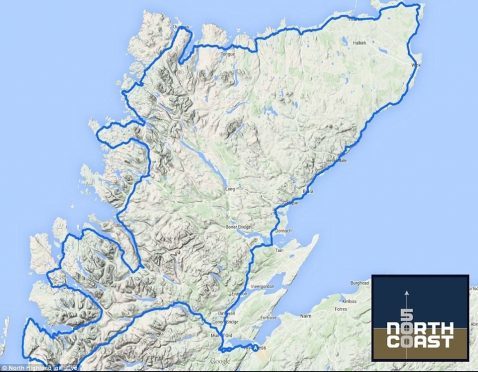NC500 bosses pledged to deliver a “lasting legacy” for the Highlands as a study showed the route had transformed the local economy.
The 516-mile loop was hailed last night for its “positive and significant impact” on the region after an analysis found that it brought in an extra 29,000 visitors and £9million in just its first year.
But business leaders and politicians also called for action to address safety concerns, and to upgrade roads and facilities on Scotland’s answer to Route 66, in order to help sustain its success.
A new report by Highlands and Islands Enterprise (HIE), which was based on telephone interviews, a survey and official statistics, found that up to 280 jobs were being created to cope with rising demand along the NC500, with trade along the route having increased by up to 20%, and road traffic by 10%.
It found the four Visit Scotland i-Centres on the loop experienced an average 26% increase in use between 2015 and 2016, compared to a 6% increase across the Highlands.
And the boost to businesses from the rise in visitors included extending the tourism season, increasing opening hours and awareness of the tourist destination, as well as triggering expansion opportunities.
Online traffic relating the NC500 indicated that interest was greatest among UK residents aged 45 or above, with males more aware than females, according to the study.
However, the report also said that some businesses had been reporting “concerns about poor and/or inexperienced driver behaviour, increasing pressures being placed on the supporting road infrastructure, and the condition of some stretches of the NC500 route”.
It said a “challenge” for organisers and public authorities lay in trying to sustain the positive impact experienced in the first year, including by maintaining roads, improving infrastructure such as toilets and parking, encouraging safer driving, and filling job vacancies.
Tom Campbell, managing director of the North Coast 500, said: “We’re delighted to see the results of this report, and the positive and significant impact that the North Coast 500 has already had on the economy of the north Highlands.
“It’s an area with so much to offer: beautiful scenery, world-class hospitality, and fascinating history, and to have this recognised globally is fantastic.
“NC500, together with businesses and communities around the route, are putting down the foundations for a lasting legacy in the northern counties.
“We are all looking forward to building on the success of the past year.”
A tour of the scenic east, north and west Highlands, the route starts and finishes in Inverness and was officially launched in May 2015 by the North Highland Initiative in an attempt to develop sustainable economic growth across the region.
Its popularity soared after being highlighted on TV shows such as Top Gear, and being named as one of the UK’s top road trips by Rough Guides.
David Richardson, Highlands and islands development manager at the Federation of Small Businesses (FSB), said local firms were considering ways to cash-in on the success.
“It is obvious to all of us privileged to live in the northern Highlands that the NC500 is having a marked impact on visitor numbers and, speaking as a former chief executive of Sutherland Tourist Board, this is to be warmly welcomed,” he said.
“However, more cars, caravans and coaches on our roads is not a good thing in itself, adding as it does to travel delays and road repair bills.
“What really matters to our fragile communities is the money that the occupants of these vehicles spend in small local businesses.”
Fraser Grieve, Highlands and Islands director of SCDI, said many businesses in the area were “thriving like never before”.
He added: “I’m sure we’ll continue to see the positive impact of this initiative over the years ahead and we need to do everything we can to ensure the businesses around our coast can capitalise on it by increasing the availability of online bookings, investing in our accommodation offer, and meeting the expectations of those who travel here.”
HIE intends its report to be used as a “baseline” to monitor the progress of the route, and called for additional data to be gathered and reviewed each year on road conditions, quality of visitor attractions, environmental impact, and marketing reach.
Highlands and Islands MSP David Stewart said the NC500 had been “remarkably successful” but added: “Of course there are shortfalls, with many locals concerned about road safety in particular and congestion on narrow single track roads which were not built for the volume of traffic they now have to carry, so we have to find a balance.”
David Oxley, HIE’s director of business and sector development, said: “This study suggests the NC500 has very quickly had a positive impact in the north Highlands.
“The long term sustainability and success of the NC500, and responding effectively to the challenges identified in the report, will require collaboration between public agencies, businesses and communities.”
Tourism Secretary Fiona Hyslop said: “Today’s report shows the route is already delivering for the north of Scotland and has tremendous potential to further benefit the communities it serves, encourage more investment in tourism facilities, stimulate jobs and expand the tourism season.
“I look forward to continuing to work with HIE and other partners to strengthen the growth we’re seeing as a result of the NC500’s introduction.”
